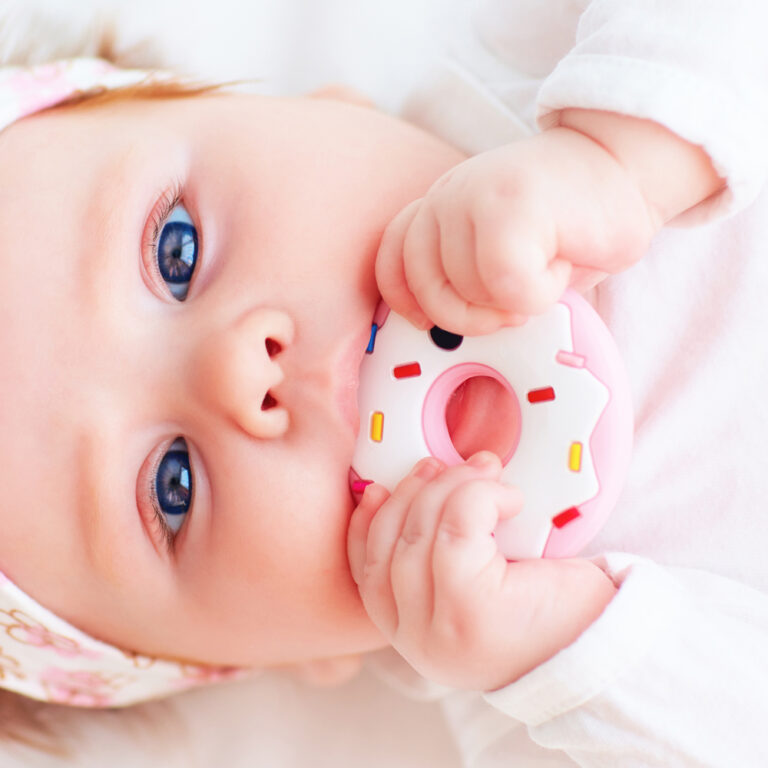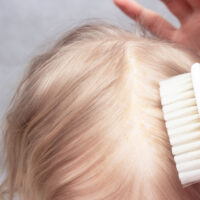Teething pain is something that all babies go through. In addition to persistent pain and fussiness, your baby is likely to show signs like excessive drooling and chewing on clothing, their fingers, toys, or anything else they put in their mouth. Unfortunately, this pain is worse at night. Below, you’ll find strategies on how to get a teething baby to sleep, so you both can get some rest.
Offer a Teething Toy
The reason babies chew on so much when they are teething is that the pressure on their gums gives soothing relief. Teething rings come in all types of shapes, textures, and colors. Some are even designed to be put in the refrigerator or frozen to provide cooling relief, too.
When looking at teething toys, you’ll want something that isn’t going to break off when your baby is chewing it. You also may want to have a variety of teething toys — certain designs might work better depending on which tooth is coming in. (You can learn more about our top picks for best baby teether here).
Another unique teething toy is a fruit mesh. You can put frozen fruit in here for your baby to gnaw at. This was one of my son’s favorites but it’s important to clean it out immediately after using it because the fruit pieces easily get stuck.
Give Your Baby a Hand (Finger)
Your longer fingers might be just the thing to reach your baby’s teeth. It’s okay to let your baby chew on a finger, just be sure you wash your hands first. You can even dip your finger in cool water, for added relief.
You can also use your finger to massage your baby’s gums. Gently press down on the gum to apply pressure and relieve pain. Just avoid rubbing back and forth; friction might cause more irritation on already sensitive gums.
Provide Cooling Relief
While frozen teething rings are a good choice for some babies, they can also be too hard on their sensitive gums. A good alternative is a frozen washcloth.
Start with a clean, dry washcloth that doesn’t have any loose threads or frayed edges. These can become a choking hazard if your baby breaks them off. Run it under cool water several times to be sure it’s rinsed clean, then wring it out so it isn’t dripping wet. Put the washcloth inside the freezer for 30 minutes to an hour and it should be ready to provide some soothing relief.
Pat the Drool Away
Many people forget about how uncomfortable drool can be when their baby is teething because they’re focused on relieving the pain of their baby’s tooth. Teething often causes excess drool, so be sure to pat that away throughout the day. Keeping the area dry also prevents rashes that are common when skin stays wet.
If you do notice redness or a rash in this area, you can also use a baby-safe moisturizer or protectant in the area. Be sure you don’t put anything that will be toxic if your baby accidentally swallows some, especially since its so close to the mouth.
Add Distractions to Your Baby’s Sleep Area
Teething pain is worst at night because your baby doesn’t have distractions from it as they do during the day. Anything that gives your baby something else to focus on if they wake up in pain might help soothe them back to sleep. A white noise machine is a good option because it provides distraction without being too stimulating or keeping baby awake. You could also consider a night light or soothing sleep machine for the nursery.
Stick to the Same Routine for Sleep
Having a good sleep routine is critical to your baby’s development. Even when he or she is fussy from teething, it’s important that your baby follows the same routine for sleep. It might be frustrating, but remember that teething is a temporary situation. Try to make your little one more comfortable so they can fall asleep on the same schedule despite their teething pain. This is also important for self-soothing.
Nurse or Feed
The suckling motion is one that often relaxes babies, so it may provide some relief when they are upset. Whether your baby is breastfed or bottle-fed, you can offer a breast, bottle, or even pacifier to help soothe them back to sleep. This was something that worked a lot for my boys at night, especially since they were both breastfed. Feeding them also provides a sense of comfort that may help relieve pain.
For mothers who breastfeed, this also might be a great source of pain relief for your baby. There are several studies that have proven that a child experiences less pain when they are drinking their mother’s milk. Some even showed that the milk didn’t need to be consumed; just the smell was enough to comfort a baby undergoing a heel stick. This means even if your baby is having trouble feeding because of their teething pain, just holding them close to your chest might be enough to provide some comfort from pain.
Be Comforting
As a parent, you have a lot of different ways you can offer comfort to your little one. Giving extra snuggles, walking them around, and calmly playing with them can all help. You might also find there’s a certain piece of baby furniture (like a rocker or baby swing) that your little one finds relaxing.
The way that you talk to your baby can also be soothing. Try to keep a calm voice and let your baby know that you are there for them. It can be hard to stay relaxed when your baby is crying and you can’t relieve their pain. However, it’s important to maintain a sense of calmness so you can provide reassurance to your baby that they are going to be okay.
Consider Baby Wearing
There are a lot of slings, wraps, and other baby-wearing accessories that help you keep your little one close. I know when my boys were younger, one of the biggest struggles was completing housework and other things when they were teething because they didn’t want me to set them down. It was also hard to get them to take a nap unless I held them. They’d wake up as soon as I laid them in their playpen or crib. My baby carrier was huge during this time.
Babywearing is great because it lets you use your hands while you keep your baby close. It also provides the comfort that they really need when they are teething. (You can learn more about our top picks for best baby carrier wrap and best ring sling here).
Take Care of Your Baby’s Teeth
Even though your baby might only have a few teeth at first, it’s important to take care of them. When your baby is young, it’s enough to rub a damp piece of cloth across the gums. They also make baby “toothbrushes” that are essentially silicone or rubber shaped to fit your finger with a few silicone bristles on the top. Cleaning the gums will help prevent the buildup of milk odor and bacteria, as well as promote a healthy environment once your baby’s teeth do start coming in. Starting early also helps encourage healthy brushing habits.
Once your baby does have teeth, you can start using an infant toothbrush and toothpaste. You will only need a small amount of toothpaste at first, and eventually a pea-sized amount once your child is three years old. However, it’s okay to skip certain areas of your baby’s mouth, especially if they are currently teething and there is an area that seems more tender than others.
FAQs – How to Get a Teething Baby to Sleep
How long does teething last?
Your baby’s front teeth are usually the first to erupt- and that can happen as early as five months. However, teething isn’t a process that happens all at once. Most babies don’t have all their teeth until they are almost three years old.
Even though teething as a whole is a long process, most babies experience teething pain for about eight days with each tooth or pair of teeth. Teething pain is most persistent in the five days leading up to the tooth erupting through the gum line and for three days afterward, as the tooth fully grows into place.
How do I know my baby is experiencing teething pain?
Even though teething pain persists most at nighttime, night restlessness doesn’t always mean your child’s emerging tooth is to blame. For example, babies are likely to have trouble sleeping after reaching a milestone like walking or talking, because it excites them. Separation anxiety, an illness or infection, and other problems might also cause nighttime restlessness.
Something else that might indicate something other than tooth pain is a fever. Fevers in babies are characterized as any temperature taken rectally that’s over 100.4 degrees Fahrenheit. While gum inflammation can cause a rise in temperature, it usually isn’t more than a degree or two. Your baby might get warm, but not so much that it could be considered a fever from teething.
Some parents also report signs like runny nose, cough, and loose stools in children that are teething. Even though these reports are common, it is not the teething itself that is the root of the problem. Teething increases the number of cytokines in your baby’s immune system. This, in turn, weakens your baby’s immune system so they are more susceptible to colds and infections when they are already teething.
Why is teething pain worse at night?
Teething pain is worse at night because your baby has fewer distractions from the pain. They are also more likely to be tired at night, so when teething pain keeps them up it causes even more distress. Many adults with chronic pain conditions also report their pain being worse at night for the same reason. Since they are relaxed and not stimulated by what’s going on around them, they are more aware of the pain.
Can I give medicine at night to help my baby sleep?
While administering Tylenol or Ibuprofen is an option, it should always be used as a last resort. Frequent use of medicines like these is harmful to your baby’s still-developing body. If you do choose to administer medicine for pain relief, be sure to talk to your pediatrician first about the recommended dosage and how often it can be used for teething pain. Follow instructions carefully to avoid giving too much medication. You should also use Tylenol or Ibuprofen for pain relief- never aspirin. Aspirin comes with an increased risk of Reyes disease.
Another common medicine for teething pain is numbing gels or teething tablets. While these might seem to work, many contain ingredients that might be harmful (like belladonna in teething tablets and benzocaine in numbing gels). Additionally, the excessive drooling that babies experience when teething washes these medications away quickly and it’s hard to tell how much of the product they are ingesting.
Final Word
Teething pain will likely be responsible for a lot of sleepless nights after a few months of age and before your baby’s third birthday. Fortunately, there are many possible remedies that you can use to ease your baby’s pain. Hopefully, these strategies on how to get a teething baby to sleep will help you both get some rest.











